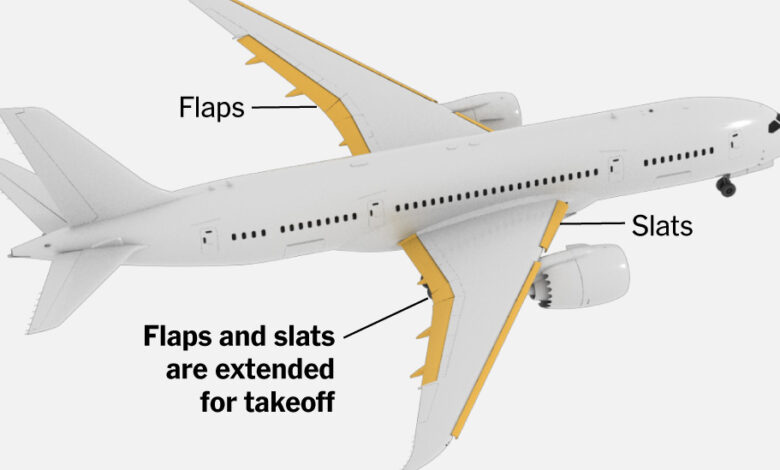What Caused the Air India Plane Crash? Here’s What Investigators Are Examining.

Investigators have started examining the debris of the recent plane crash in India, the deadliest in the country in thirty years. It might take several months before a conclusive explanation is determined, but initial evidence and videos of the incident have provided some insights into what could have caused the Air India flight to crash, resulting in the loss of over 260 lives.
Here are some key questions that aviation safety experts hope to address in the coming days and weeks.
Were the wing flaps and slats properly extended?
The crash occurred shortly after the plane took off from the airport in Ahmedabad, India. A brief, unclear video showed what seemed to be a normal takeoff, according to aviation safety experts. However, the Boeing 787 Dreamliner started descending soon after lifting off before crashing and exploding.
Fundamentally, the crash indicated a failure to meet the basic requirements of flight. For flight, a plane must generate enough lift to counteract gravity and enough thrust to overcome air resistance, also known as drag. It seemed that the flight on Thursday failed on both these fronts.
“There seemed to be issues with the thrust and lift,” stated Anthony Brickhouse, an aviation safety consultant. “And unfortunately, we saw the outcome of those issues.”
During takeoff, flaps at the rear of the wing and slats at the front are typically extended to increase surface area and create more lift as the plane gains speed.
“Given that this was a takeoff accident, it raises questions about the settings of the wing slats and flaps, which are crucial for taking off in a fully loaded jet,” explained Jeff Guzzetti, a former accident investigator for the Federal Aviation Administration and National Transportation Safety Board.
It was unclear whether the flaps and slats were properly extended. If not, experts noted that investigators would want to determine why. Did the pilots choose not to extend them or forget to do so? Was there a mechanical issue preventing the extension of these parts? Even if the flaps and slats were extended, it would be challenging to ascertain if they were correctly deployed as they can be configured differently for various situations. It’s also possible that they were extended but retracted prematurely.
“The video quality is insufficient, but this information is typically recorded in the flight data recorder,” said Mr. Guzzetti. “So hopefully, the recorders will provide the necessary details.”
Why was the landing gear down?
The video indicates that the landing gear remained extended during the plane’s ascent and descent, which experts found unusual. Landing gear creates drag, so retracting it is typically one of the first actions pilots take after the plane is airborne.
However, experts mentioned that the pilots might not have retracted the gear for various reasons. For instance, a mechanical issue could have prevented the pilots from raising the landing gear, or they could have been preoccupied with another more urgent problem.
“The airplane can climb fine with the gear down,” noted Shawn Pruchnicki, a former accident investigator at the Air Line Pilots Association and an assistant professor of aviation safety at Ohio State University. If there was another issue on the plane, the pilots may have prioritized addressing that first, he explained: “You have alarms going off — there’s a lot happening.”
Were there engine problems?
Engines provide thrust, and investigators will want to determine if they failed due to any reason. Engine failures sometimes come with visible signs such as smoke, fire, or flashes, but experts noted that none of these were clearly visible in the blurry crash videos.
One video showed what seemed like a dust cloud shortly after the plane took off. This could have been caused by an engine issue or by the wingtips disrupting the air, experts suggested.
Planes are designed to fly with a single engine, a scenario that commercial airline pilots extensively train for, stated Mr. Pruchnicki, adding that he believed the 787 Dreamliner likely didn’t experience a single engine failure, but both engines might have malfunctioned.
If that were the case, it would have occurred at the worst possible time,” said Mr. Pruchnicki. A dual engine failure right after takeoff, when the plane was only a few hundred feet above ground, would have left the pilots with little time to respond to the emergency.
“You can’t manage a double engine failure that close to the ground,” he remarked, recalling the 2009 “Miracle on the Hudson” incident when a US Airways jetliner landed in the Hudson River after losing power in both engines due to a bird strike. “These pilots were in a populated area, a commercial area. They had nowhere to go. There was no field to land gently on.”
Unfortunately, their journey took an unexpected turn as they found themselves inside buildings.
The failure of both engines could have been caused by various factors such as a bird or drone strike, inadvertent fuel shut-off, or issues with automated thrust management. However, there is no evidence to suggest that these issues contributed to the crash on Thursday.
“There are countless possibilities to consider,” Mr. Pruchnicki stated. Examining the flight data recorder and inspecting the engine would provide valuable insights into the incident.
Investigators will focus on unraveling what transpired in the flight deck before the crash. With two pilots on board, one responsible for flying and the other for monitoring systems, questions arise about the division of duties and the pilots’ communication and performance.
Planes are equipped with warning systems to alert pilots of potential problems, raising concerns about whether these systems functioned correctly. Understanding if the pilots received the necessary warnings and how they responded is crucial in the investigation.
In addition to analyzing wreckage and gathering witness testimonies, investigators will prioritize retrieving data from the black boxes – the flight data recorder and cockpit voice recorder. This wealth of technical information and audio recordings will guide the investigation towards specific areas of focus.
John Cox emphasized the importance of gathering documentation and evidence while maintaining an open mind throughout the investigation process. Rewrite the sentence:
The quick brown fox jumps over the lazy dog.
Rewritten Sentence:
The fast brown fox leaps over the inactive dog.





